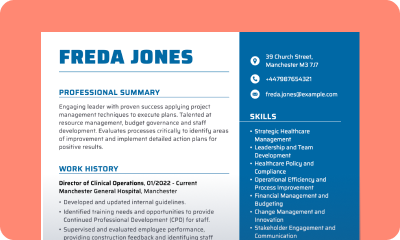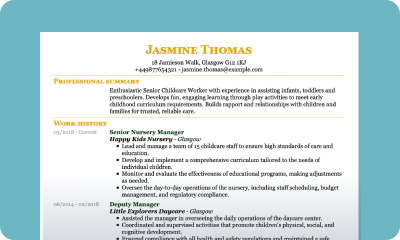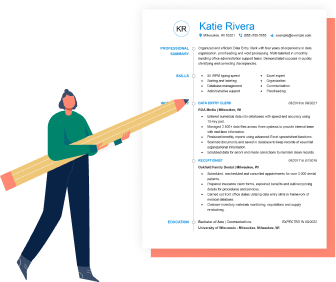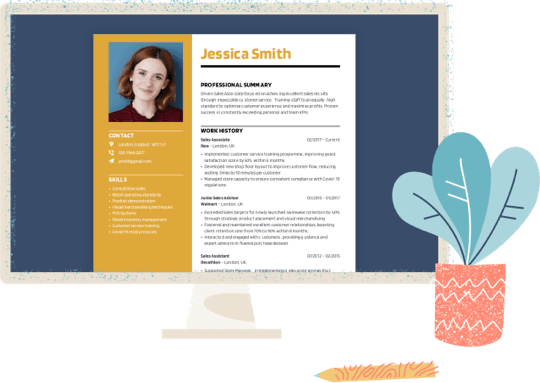Cambridge University CV example
Get started with your Cambridge CV today. Whether you are applying for your first academic post or updating your CV for new research opportunities, this clear, professional format helps you highlight your academic achievements, skills and experience effectively. Use our free CV templates for both academic applications and professional roles.
Dylan Cooke
Cambridge, CH2 6ST
+44 7890 123456
dylan.cook@example.com
Profile
Early-career researcher specialising in public policy evaluation and quantitative methods. Experienced in designing mixed-method studies, publishing peer-reviewed work and presenting findings to academic and non-academic audiences. Keen to contribute rigorous analysis and clear communication to research projects with social impact.
Education
PhD, Social and Political Sciences
University of Cambridge
(Oct 2021 – Jul 2025)
Thesis: “Measuring Policy Uptake in Local Government” (Supervisor: Prof A. Chen)
- Developed an original difference-in-differences framework; validated on a dataset of 120 councils.
- Publications from thesis: 2 peer-reviewed journal articles; 1 revise-and-resubmit.
- Awarded Faculty Studentship (full funding) and Best Paper Prize (2024).
MPhil, Public Policy
University of Cambridge
(Oct 2020 – Sep 2021)
- Distinction; dissertation on behavioural nudges in council tax compliance.
- Methods: R, Stata, survey design, causal inference.
BA (Hons), Politics and Economics
University of Warwick
(Sep 2017 – Jun 2020)
- First Class; top 5% of cohort.
Research Experience
Graduate Researcher, Centre for Local Policy Studies,
Cambridge
(Jan 2022 – Jul 2025)
- Led quantitative workstream on service delivery outcomes across 87 authorities, improving model accuracy by 14% vs baseline.
- Co-authored policy brief adopted by two county councils.
Research Assistant, Behavioural Insights Lab,
Warwick
(Jul 2019 – Jun 2020)
- Ran field experiment (n=3,400) on message framing; increased response rates by 9.8%.
- Cleaned and documented datasets to UK Data Service standards.
Publications (selected)
- Wright, E. & Chen, A. (2024). Policy Uptake and Administrative Capacity. Journal of Public Policy.
- Wright, E. (2023). Targeting Effects in Local Tax Compliance. Policy Studies Review.
- Conference papers: APSA 2024; PSA 2023 (best postgraduate paper shortlist).
Grants, Awards & Scholarships
- Faculty Studentship (2021–2025) — full fees + stipend.
- Best Paper Prize, SPS Graduate Conference (2024).
- Small Research Grant (£2,000) for primary data collection (2023).
Teaching & Supervision
College Supervisor, Introduction to Quantitative Methods
(2022 – 2025)
- Supervised 24 undergraduates per year; average teaching evaluation 4.8/5.
Guest Lecturer, Policy Evaluation (MPhil)
(Lent 2024)
- Designed and delivered a session on causal inference with an applied lab.
Work Experience
Policy Analyst (Intern), Department for Levelling Up,
Housing and Communities
(Jun 2021 – Sep 2021)
- Built dashboards in R/Shiny used by a 12-person team to track grant allocations.
- Drafted briefing notes for senior officials; two recommendations adopted.
Student Services Assistant,
University of Warwick
(Sep 2018 – May 2019)
- Streamlined enquiry triage, cutting response time from 3 days to 24 hours.
Skills
- Methods: Causal inference, survey design, experimental design, data visualisation.
- Tools: R, Stata, Python, SQL, LaTeX, Git.
- Communication: Academic writing, policy briefs, public presentations.
- Languages: English (native), French (intermediate).
Professional Memberships
Political Studies Association (PSA), UK Data Service Users’ Group.
References
Available on request.








